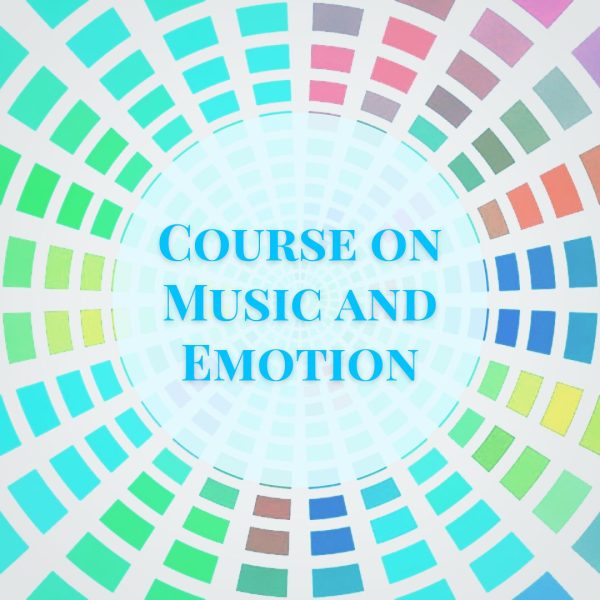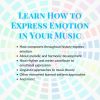Music and Emotion
Music and emotion are intertwined.
One of the most common questions musicians ask is, “How do I express feelings through music?”
Almost everyone experiences music in at least a somewhat emotional way. This may be by being the recipient of emotions that music expresses or by experiencing an emotion internally when listening to music.

But how does this happen? And why does this happen?
If you’re asking these questions, you’ve come to the right place.
In this course on Music and Emotion, you’ll learn how specific elements of music contribute to expressing emotions. These include melody, harmony, and rhythm and meter, but of course there’s more to learn.
A big part of why we seem to feel emotions with music is as a form of intimate communication and connection. Experiencing emotion while making and listening to music may have been a survival trait that has kept us connected deeply.
When we’re connected as a group, we’re safer.

Even when you’re alone, music connects you to others.
Breakup songs, songs of hope, songs to give you a little pep in your step: they all remind you that someone else has felt the same way you do now. Music helps you through the bad times by validating the emotions you feel, and it accompanies you in the good times by moving with you.
It’s why a lot of musicians started playing or singing.
It’s why I did.
And I’m sure it’s at least part of why you love music too, if you’re here.
Maybe you’re not a formal instrumentalist or a vocalist. Maybe you have no desire to actually make music. But as long as you love music and are curious about how and why music expresses emotion so deeply, you’ve come to the right place.

In the Music and Emotion Course, You’ll Learn
- Specific elements that contribute to expressing emotion in music
- How the way we express emotion vocally and in our bodies relates to emotion in music
- To create narratives or atmospheres of specific emotions in music
- How to categorize emotions into 4 categories that relates to the way they’re expressed
- What specific composers, songwriters, and producers do in their music to express emotion
Testimonials From All Courses
[twb_wc_reviews product_id=”13484,11660,6473″ number=”5″]


How You’ll Learn About Music and Emotion
In the Music and Emotion Course, you’ll start by learning about emotional expression in everyday life, starting with how you can categorize emotions across 2 dimensions: pleasantness and activity level.

This emotion wheel is a helpful illustration for thinking of emotions based on the way we express and feel in our bodies when we experience them.
Music and Emotion is divided into 4 units: one for each quadrant:
- Active, Pleasant: Happy, Joyful, Blissful, etc.
- Passive, Unpleasant: Sad, Bored, Gloomy, etc.
- Active, Unpleasant: Angry, Frustrated, Annoyed, etc.
- Passive, Pleasant: Calm, Peaceful, Serene
In each unit, you’ll explore how the basic elements of melody, harmony, and rhythm and meter typically express emotion by drawing from studies of linguistics and embodied cognition and using these as an analogy for how emotions act in a musical landscape.
Although you don’t have to make your own music in Music and Emotion, you’ll receive helpful prompts and templates to create your own emotional music. There’s also a community group to share and collaborate with others taking the course with you!
What levels of musician is Music and Emotion for?
To ensure you can keep up with the material, you’ll need to be comfortable reading sheet music and building chords. If this isn’t you, you’ll likely still get a lot out of the course.
The only other pre-requisite is a massive curiosity and desire to learn more about human beings interact with music and emotions.
This course is meant for you if you’ve always wondered why some music gives you chills, makes you cry, or motivates you to stand up and keep going.
What’s Inside the Music and Emotion?
Expand for Music and Emotion Course Schedule
Course Content
In addition to these in-depth lessons, you also get:
- Access to an exclusive community
- Personalized feedback and help
- Discussion boards
- Composing prompts and templates
- Worksheets and other downloadables that you can use for reference later
The Price of Music and Emotion
A goal for Girl in Blue Music is to make music education resources more accessible to everyone. That means choosing prices that are options for students but still allow these courses to support the cost of running the platform.
For this Music and Emotion course to be worth your time and mine, the price is set at $400 for lifetime access to the course, the community, the worksheets, and everything else associated with the course.
And remember, your first purchase is 15% off when you sign up for the email list!
If this is too much for you at once, Paypal Later offers payment plans, so you can break the payment into monthly installments.
If that’s still not an option for you financially, but you still see clear benefit for you and the community, then send me an email at [email protected]. There are a limited number of scholarships available each month, as part of the purpose of this platform is to make music education resources more accessible to everyone.
About Your Instructor
Hi, I’m Amy!

I’m a 2nd-year PhD studying Music Theory & Cognition.
I love learning about how music plays with our emotions and connects us with each other.
I also love teaching, which is why you’ll find me teaching music theory on social media (@girlinbluemusic).
Music is something I believe everyone should have the chance to learn, so I’m doing everything I can to support affordable music education around the world.
Even if you don’t purchase anything from me, I hope you got at least one big takeaway from this platform: the music you want to make is already in you.
You just need some help getting it out of you!
No matter what you choose to do, I’m here to help you become the best musician you can be!
30-Day Money-Back Guarantee
Every digital product at Girl in Blue Music comes with a 30-day money-back guarantee to ensure that you feel you are getting your money’s worth. If the course doesn’t meet your expectations, then send me an email within 30 days of purchase for your refund.

My hope is that you’ll feel that you got the course for a steal instead! That it’s worth thousands of dollars, and somehow you were fortunate to stumble upon it. That’s my goal!
What are you waiting for?
Start learning and making music that expresses you.

Frequently Asked Questions
Music and Emotion has 4 units with 5 lessons in each. Each lesson is around 25–30 minutes long.
If you complete a lesson a day, you’ll finish in about a month. You could likely do more than a lesson a day, but I recommend you take your time with it.
If you’re joining the course when it drops, each lesson will be dripped out, about 1–2 lessons a week. That’s a good pace to keep up that will give you time to make music and find examples of specific emotions in your favorite music. It’ll also give you time to write your own music to share with the course group for feedback, if that’s something you’re interested in!
Learning isn’t always linear: sometimes we get stuck. To get unstuck, you’ll need a helping hand. That’s why you’ve got a whole community of people learning alongside as well as personalized help from me. No need for fear here!
Call or email using the information below. Contacting during business hours (US Central time) will get a prompter response, but you should hear back within 48 hours!
- Monday
- 9:30 am – 5:30 pm
- Tuesday
- 9:30 am – 5:30 pm
- Wednesday
- 9:30 am – 5:30 pm
- Thursday
- 9:30 am – 5:30 pm
- Friday
- 9:30 am – 3:00 pm
- Saturday
- 10:30 am – 4:00 pm
- Sunday
- 10:30 am – 4:00 pm
You can access all account information (orders, shipping addresses, payment methods, downloads, course dashboard, community profile, groups, and more) at your personal dashboard. There are tabs for each of these, but payment and shopping information is located specifically in the shop tab.
If you do not yet have an account, you can create one here. Purchases through the shop automatically create an account.
Refund Policy
All digital items have a 30-day satisfaction money-back guarantee. If you’re dissatisfied with your purchase, use email [email protected] to file a claim, and I will get back to you within 48 hours regarding the details of the return.
Once your case has been opened (within 48 hours of your claim), you will receive an email regarding the specifics of the case. If your return and refund is approved, I will initiate a refund to your original method of payment.
You will receive the credit within a certain amount of days, depending on your card issuer’s policies.
WooCommerce hosts all of the products on this website. This means that the following payment methods are accepted, and your payments are handled securely:
- Paypal
- Stripe
- Visa
- Mastercard
- Discover & Diners
- American Express
- China Unionpay
- Japan Credit Bureau
- Bank Transfers via Paypal
All of the sheet music and pdf activity packs on this website include a “studio license,” meaning you may distribute the materials to your teaching studio. If you’re not a teacher, you may share materials with close friends. You may not re-sell or otherwise massively re-distribute material on the internet or in any other capacity without written consent of the author/composer.
Courses are intended only for the individual who made the purchase or in case of minors, a parent or guardian may purchase for their child. Courses may not be shared.
For questions regarding this policy, email [email protected]
If you are experiencing any issues with a product, contact me at [email protected], and I will help you resolve any product issues.
Good to stay curious! Email me with any other questions at [email protected] or call (847) 868-2123 during business hours.







Reviews
There are no reviews yet.